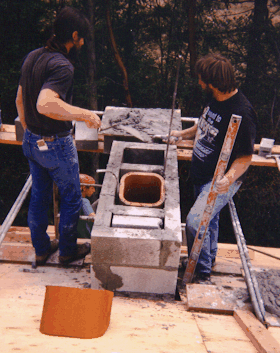**********
X
-
Re: Somebody stop me!
If it's freestanding and outside, there's no problem with a plain common brick chimney. I mean people make them out of plain single wall stove pipe without burning anything down. What's to burn down?
If it's a part of the house, different story, it has to be to code.
-
Re: Somebody stop me!
Dlachez,
I've worked on many, many 18th and 19th century flues, and they're ALWAYS just brick, corbelled for the first foot to two feet. The major problem with them is age, the hardness of the brick and the fact that fireplace chimneys don't get all that warm, leading to creosote deposits. You're dealing with a pizza oven, with relatively high flue temps, so creosote is much less, if a not nonexistent, issue. Can be done. But the question is why would you want to? Using a liner is safer and easier if cleaning needs to be done. Liner is cheap. I'd go that route if you have a choice.
Jim"Made are tools, and born are hands"--William Blake, 1757-1827
Comment
-
Re: Somebody stop me!
$12 for 9x9x24 inch clay liner at my local brickyard. Plus, you can get a cap/spark arrestor that fits nicely.
-CC
Comment
-
Re: Somebody stop me!
and that's exactly what building code calls for: one inch of mortared refractory flue liner, free standing, braced only by the chimney cap on top, half an inch of air space, and four inches of brick or block on the outside. A chimney built like that can be cleaned, and will last for a century or more.Originally posted by CanuckJim View PostDlachez,
That's exactly what I did: flue tile, air gap, brick.
Jim
Comment
-
Clay or metal liner?
Jim, and Dave,
(M) Please clarify for me what I am looking at in the image of dlachez (Tim).
(M) What I see extending from the top of the dome seems to be 2 courses of red brick into which a steel walled flue has been inserted.
(M) How are you gleaning that a clay liner is installed? ___
Thanks, and ciao,
Marcel"Everything should be made as simple as possible, ...
but no simpler!" (Albert Einstein)
Comment
-
Re: Somebody stop me!
Usually the flue tile and the surrounding masonry are built up at the same time: a piece of flue tile is refractory mortared to the one below it, and then the outside masonry is built up around it. Trying to insert a flue tile into an already built chimney would be difficult if not impossible. Here's a pic from Rumford Fireplaces:

Comment





Comment